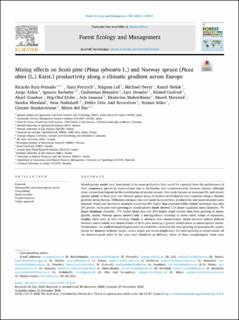| dc.contributor.author | Ruiz-Peinado, Ricardo | |
| dc.contributor.author | Pretzsch, Hans | |
| dc.contributor.author | Löf, Magnus | |
| dc.contributor.author | Heym, Michael | |
| dc.contributor.author | Bielak, Kamil | |
| dc.contributor.author | Aldea, Jorge | |
| dc.contributor.author | Barbeito, Ignacio | |
| dc.contributor.author | Brazaitis, Gediminas | |
| dc.contributor.author | Drössler, Lars | |
| dc.contributor.author | Godvod, Kšištof | |
| dc.contributor.author | Granhus, Aksel | |
| dc.contributor.author | Holm, Stig-Olof | |
| dc.contributor.author | Jansons, Aris | |
| dc.contributor.author | Makrickienė, Ekaterina | |
| dc.contributor.author | Metslaid, Marek | |
| dc.contributor.author | Metslaid, Sandra | |
| dc.contributor.author | Nothdurft, Arne | |
| dc.contributor.author | Reventlow, Ditlev Otto Juel | |
| dc.contributor.author | Sitko, Roman | |
| dc.contributor.author | Stankevičienė, Gintarė | |
| dc.contributor.author | del Río, Miren | |
| dc.date.accessioned | 2021-10-20T07:33:57Z | |
| dc.date.available | 2021-10-20T07:33:57Z | |
| dc.date.created | 2021-01-25T17:23:56Z | |
| dc.date.issued | 2020-12-15 | |
| dc.identifier.citation | Forest Ecology and Management. 2021, 482 . | en_US |
| dc.identifier.issn | 0378-1127 | |
| dc.identifier.uri | https://hdl.handle.net/11250/2823991 | |
| dc.description.abstract | Mixed-species stands have been found to be more productive than would be expected from the performance of their component species in monocultures due to facilitation and complementarity between species, although these interactions depend on the combination of species present. Our study focuses on monospecific and mixed-species stands of Scots pine and Norway spruce using 20 triplets established in nine countries along a climatic gradient across Europe. Differences in mean tree and stand characteristics, productivity and stand structure were assessed. Basal area increment in mixed stands was 8% higher than expected while volume increment was only 2% greater. Scots pine trees growing in mixed-species stands showed 11% larger quadratic mean diameter, 7% larger dominant diameter, 17% higher basal area and 25% higher stand volume than trees growing in monospecific stands. Norway spruce showed only a non-significant tendency to lower mean values of diameters, heights, basal area, as well standing volume in mixtures than monocultures. Stand structure indices differed between mixed stands and monocultures of Scots pine showing a greater stratification in mixed-species stands. Furthermore, the studied morphological traits showed little variability for trees growing in monospecific stands, except for diameter at breast height, crown length and crown length ratio. For trees growing in mixed stands, all the morphological traits of the trees were identified as different. Some of these morphological traits were associated with relative productivity. Nevertheless, relative productivity in mixed-species stands was not related to site conditions. | en_US |
| dc.language.iso | eng | en_US |
| dc.publisher | Elsevier B.V. | en_US |
| dc.rights | Navngivelse 4.0 Internasjonal | * |
| dc.rights.uri | http://creativecommons.org/licenses/by/4.0/deed.no | * |
| dc.title | Mixing effects on Scots pine (Pinus sylvestris L.) and Norway spruce (Picea abies (L.) Karst.) productivity along a climatic gradient across Europe | en_US |
| dc.type | Peer reviewed | en_US |
| dc.type | Journal article | en_US |
| dc.description.version | publishedVersion | en_US |
| dc.rights.holder | © 2020 The Author(s) | en_US |
| dc.source.pagenumber | 13 | en_US |
| dc.source.volume | 482 | en_US |
| dc.source.journal | Forest Ecology and Management | en_US |
| dc.identifier.doi | 10.1016/j.foreco.2020.118834 | |
| dc.identifier.cristin | 1878866 | |
| dc.relation.project | EC/H2020/778322 | en_US |
| dc.source.articlenumber | 118834 | en_US |
| cristin.ispublished | true | |
| cristin.fulltext | original | |
| cristin.qualitycode | 2 | |

